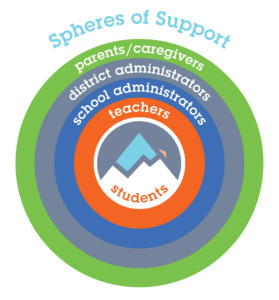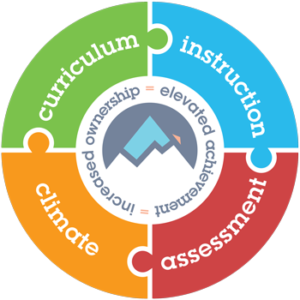Share this article.
Elevated Achievement exists because we believe that in order for each and every learner to elevate their achievement, they must own their learning. But to truly do that each and every stakeholder must be supported so that the students benefit from all levels of support. That’s why we are committed to supporting not just teachers, not just site-level administrators, not just parents and caregivers, but also district-level administrators. To that end, we have provided a series of articles focused on the actions a district-level administrator can take to develop their own instructional leadership. We have shown that instructional leadership is the key to supporting all stakeholders. We have shown that the task of the principal is to lead the initiatives that will increase student achievement. And we have shared the strategic learning practices and actions of instructional leadership that principals can use to support their teachers when implementing these initiatives at the highest level.
However, the practices and actions aren’t just for use with principals and their teachers. They can be used by anyone who is supporting someone else’s learning. When a principal is leading the implementation of an initiative, they, too, need support. This support needs to come from their supervisor, the district administrator.
Thus, we all have a role in supporting our students.
The Spheres of Support
 Consider the Spheres of Support as you think about your school and district. If a school or district is truly student-centered, then each educational stakeholder in the system has very specific responsibilities. These responsibilities identify the vital, and unique, roles of teachers, school-site administrators, district-level administrators, and parents and caregivers.
Consider the Spheres of Support as you think about your school and district. If a school or district is truly student-centered, then each educational stakeholder in the system has very specific responsibilities. These responsibilities identify the vital, and unique, roles of teachers, school-site administrators, district-level administrators, and parents and caregivers.
The vital role of teachers is to consistently and intentionally support students to own their learning. The vital role of school-site administrators is to utilize the actions of instructional leadership to consistently and intentionally support teachers to own their role in student learning. The vital role of district-level administrators, as articulated in this article, is to utilize the actions of instructional leadership to consistently and intentionally support schools-site administrators to own their role of leading initiatives that elevate student achievement. The vital role of parents and caregivers is to consistently and intentionally support their child to own their role in learning at home, thereby reinforcing the support students are receiving at school.
Thus, just like with principals, of all the skills a district administrator needs to succeed, the most vital in terms of increasing academic achievement is that of instructional leadership. The skill of instructional leadership is made up of actions that can be seen and heard. And we believe that the actions of instructional leadership can be developed and should be developed at all levels in a district.
How You Can Develop Instructional Leadership at the District Level
What is leadership? If you were to look up this word, you would find myriad definitions. But, regardless of the intent or details of the wording, most definitions will identify leadership in some form or fashion as the art of inspiring a group of people toward achieving a common goal. This reminds us that regardless of the business being led, leadership is linked to a goal. It is no different in education. So, when we talk about leadership in the context of education, we know we are talking about the art of inspiring a group of people toward achieving a common set of goals for learning and academic achievement.
However, we are less concerned with a definition and more concerned with the practical answer to the question, “What are the actions of a district administrator who effectively supports a principal who leads a school with the performance outcome of elevated academic achievement for each and every student?”
In other words, “What are the actions of instructional leadership?” For us, the actions of instructional leadership fall into the four categories—curriculum, instruction, assessment, and climate. In another article, we articulated what those actions look like and sound like when they are utilized. We also shared that instructional leadership takes into account the motivation and the capacity of the learner to implement the work. In addition, we made the case that the most efficient way to understand the thinking behind a learner’s approach is to ask questions. And, equally critical to the outcome of elevated academic achievement for each and every student is the collective clarity of all stakeholders through overcommunication.
The purpose of this article is to clarify for you the actions of instructional leadership for a district-level administrator. If these actions are followed, you will be exemplifying the skills of instructional leadership, and, thus, you will be a district administrator who supports each and every principal to lead a school with the stated performance outcome of elevating academic achievement for all students. Districts and schools are continuously analyzing student performance data and determining actions, or initiatives, that could be implemented to accelerate learning.
There are a variety of initiatives that may be implemented. Some might be at the district level—all English teachers are expected to follow the newly created scope and sequence, the use of newly-adopted resources, or course-alike teacher cohorts will analyze student data using the district assessments. Some might be at the school level, based on specific site needs—the instructional strategy of reciprocal teaching will be used with English learners or the mathematical practices will be a focus in our pre-algebra and algebra classes.
With both types of initiatives, your task is to support your principals. If the initiative is district-based, your task as a district administrator is to direct and support your principals as they lead the implementation of this initiative. If the initiative is site-based, your task as a district administrator is to monitor and support your principals as they lead the implementation of a school-based initiative.
In either case, the actions of instructional leadership can be organized into a framework with four categories and are undergirded by the understanding that all support and learning is driven by:
- A clearly defined initiative with measurable and achievable outcomes
- Highly engaging, effective, and efficient instruction
- Regular assessment that guides decision-making
- A positive climate
Within this framework are the actions of instructional leadership in the areas of curriculum, instruction, assessment, and climate that you must take if an initiative is to be implemented at the highest level.
The Actions of Instructional Leadership at the District Level
Curriculum:
- Clarify the goals of the initiative.
- Integrate the goals of the initiative with other expectations.
- Provide the resources needed to implement the initiative.
- Share this information with the principal.
Instruction:
- Clarify how the initiative will be supported and implemented.
- Establish a plan for professional learning opportunities.
- Schedule professional learning opportunities directly related to the initiative.
- Share this information with the principal.
Assessment:
- Confirm the success criteria of the initiative.
- Establish a method for monitoring the implementation of the initiative.
- Establish a method for continued support of implementation.
- Share this information with the principal.
Climate:
- Identify the role of the principal in the implementation of the initiative.
- Foster cooperation and collaboration between principals.
- Encourage risk-taking with the principal.
- Share this information with the principal.
Not one of these actions regarding curriculum, instruction, assessment, and climate, can be utilized in isolation. Each action will impact other actions. It is your job to decide how these areas work together to ensure that there is the highest likelihood of successful implementation. Your greatest power lies in your decision-making. And if your decision-making is based on the actions of instructional leadership, you will find that increased ownership leads to elevated student achievement.
Continue the Learning
Check out these articles and resources to continue your learning about this topic…
The Learning Brief
In this article you learned…
- That any administrator can increase district-wide motivation, and thus achievement, by increasing ownership.
- The actions of instructional leadership in curriculum, instruction, assessment, and climate that actually increase the opportunities for learning—and increase the opportunities for ownership.
- How to utilize the actions of instructional leadership to build a climate of ownership in your district.
Can you imagine building an environment full of motivated, engaged, and eager students who own their learning?
We can.


